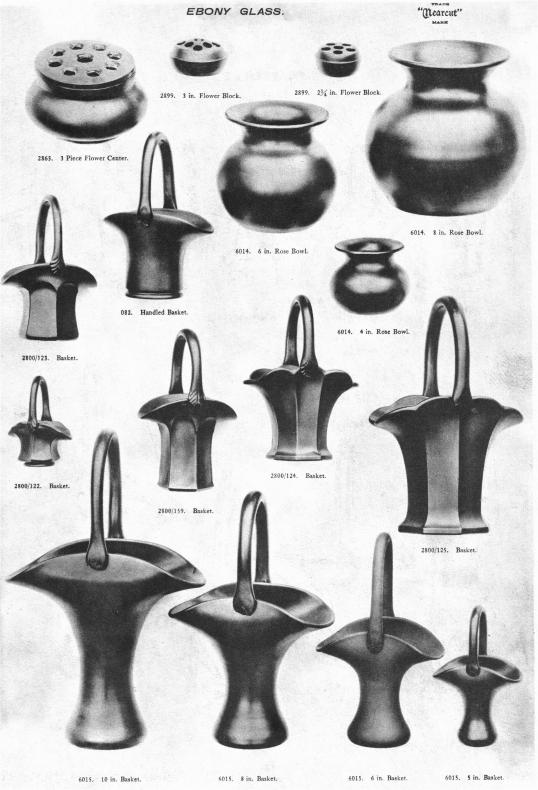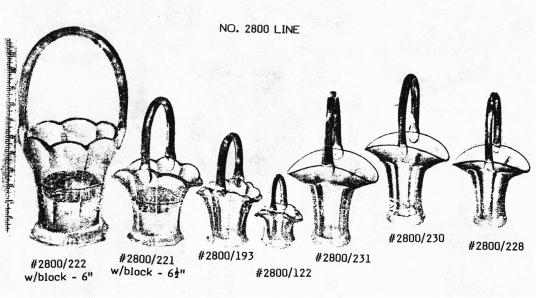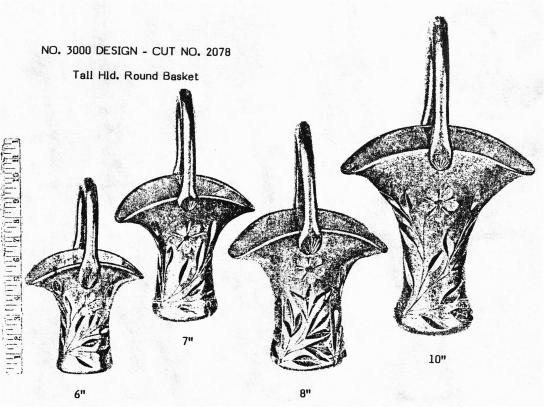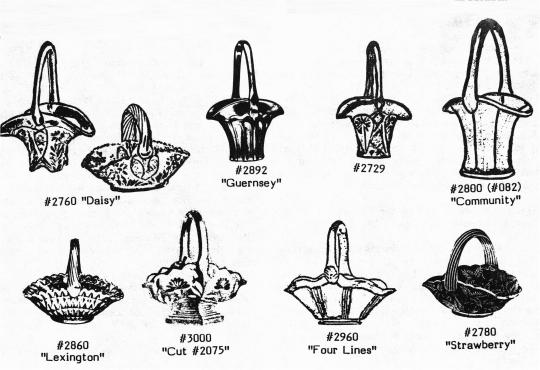Baskets - Part I
by Mark A. Nye
Issue No. 167 - March 1987
For the April 1976 issue, Phyllis Smith authored an article that featured seventeen Nearcut baskets. This current article expands on the work she did; utilizing material that has become available in the ensuing years. If you were to read the first part of this article without knowing the topic, it would be difficult to ascertain exactly what the actual object of attention is, as so much varied information is provided.
The material presented in these opening paragraphs suggests several subjects worthy of our attention, but they must wait for another time. Starting this month's article is a series of trade journal excerpts that at some point deal with the subject at hand, baskets; and the source is, unless otherwise stated, Crockery and Glass Journal.
From the January 14, 1915 issue comes the following description of the then current Pittsburgh Show.
"A full line of blown and pressed stemware is shown, and the patterns prove that great advancement has been made in this department. No new pressed lines are on view, but many new pieces of utility have been added to the Colonial line. The jugs in a great variety of treatments, as also are the vases, handled baskets; candlesticks, molasses cans and many other popular items are displayed. The exhibit as a whole is one of the most attractive of the Fair."
That Fall, the October 14th issue contained this paragraph.
"The Cambridge Glass Co. have brought out a line of well selected pieces in a combination pressed and cut design known as No. 3000. It is a prettily-arranged floral treatment, the leaves being pressed and the flower in a well executed light cutting. An attractive feature of the line is its odd shapes. Several styles of nappies are shown, deep and shallow; baskets, square footed mayonnaise bowls, partitioned trays, etc."
The January 10, 1916 edition of China, Glass and Lamps described the offerings of Cambridge at the 1916 Pittsburgh Show thusly.
"Numbered among this season's new offerings are the Marjorie deep plate etching blown ware, emerald green vases and baskets; blown, pressed and cut floral items; light cut wares; vases and baskets; a fine array of Ebony Black novelties; flower bowls and flower holder blocks; and some pieces in Royal Blue."
Returning to Crockery and Glass Journal, and an issue dated three days after the preceding, we find the same display described in this manner.
"One of the most novel exhibits is that of the Cambridge Glass Co., which is showing three new lines of glass - blue, black and green - comprising flower blocks, bowls, vases, handled baskets, and a host of other novel pieces."
In June of 1916 a new color was making news.
"The Cambridge Glass Co., always striving for something new, is showing for the first time a new glass called "Mulberry" in a number of specialties. This company has also just brought out a handled cut glass flower basket which includes a stem or flower holder."
July 1916 saw Mulberry continuing to warrant attention.
"The "Mulberry" line of glassware being shown by D. King Irwin from the Cambridge Glass Co. is proving one of the successes of the season. The richness of the color and the long list of pieces are factors that are making it so popular. There are odd shapes in stemware in solid mulberry color; also with crystal bowls and mulberry stems, vases, comports, baskets ... "
A year later, June 7, 1917 the following appeared.
" ... Another line ... recently placed on exhibit is an assortment of baskets, vases, etc. in a beautiful engraved and cut design."
This gives you some idea of the role the baskets played in the Cambridge line during the early years as well as interesting information totally unrelated to the current subject. At times it proves difficult to associate trade journal descriptions with specific items in the Cambridge line, mainly due to the fact that often the information provided was general in nature, for example, "new glass basket." Sometimes the lines of pieces mentioned in a trade journal story never found their way into a Cambridge catalog and hence we may be examining catalogs trying to find a match that doesn't exist. The point of all of this is that it is next to impossible to identify most of the baskets referred to in the preceding paragraphs, the #3000 line, along with the Ebony pieces being two exceptions.
Now we go back in time, to 1903 and the first Cambridge catalog and in it we find our first Cambridge glass basket. It is on a page titled "Opal Novelties" and is captioned "Basket. Packed 16 dozen to barrel." This apparently was not an item of any great size based on the number packed in one barrel. This novelty basket is the only one appearing in the 1903 catalog.
Five baskets appear in the 1910 Cambridge Catalog. The first is from the "Nearcut" Colonial Design #2750 with the line being described thusly.
"For elegance and good taste, this pattern is unequalled. The line contains very finely modeled and practical pieces. We pay great attention to the quality and finish of this pattern, every pieces is full finished by Natural Gas process and is fit to become a part of any good table service."
The price list described the basket as: "Hdl. basket, diameter 8 ½", height 9"."
"A very sensible plain cut fluted pattern that is of colonial effect, but very low in price. When finished it is extremely bright and makes a good stock pattern." This is how the 1910 catalog described Design #2630, later to be known as Plymouth, from whence our second basket comes. Basket number three comes from line #2693 described, in part, by the catalog in this manner.
"It has good weight and all the effective brilliancy of the higher priced lines."
Higher priced lines in this case no doubt refers to actual cut glass being produced by other manufacturers.
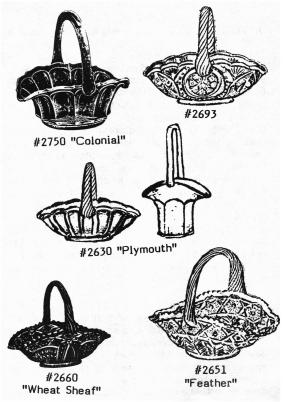 From the Wheat Sheaf or #2660 line and the #2651 or Feather line
come the last two baskets found in the 1910 catalog. The latter line
carried this caption in the catalog.
From the Wheat Sheaf or #2660 line and the #2651 or Feather line
come the last two baskets found in the 1910 catalog. The latter line
carried this caption in the catalog.
"Brilliant imitation of the famous Feather cut. Pattern full of reflecting brilliancy and moderate in price."
The next known catalog to contain baskets is one issued circa 1916 and in it we find a wealth of baskets; over thirty baskets are pictured or mentioned. Some of the patterns were previously encountered in the1910 Catalog; Colonial or #2750, #2660 or Wheat Sheaf; and #2630 or Plymouth.
"For starters there is the #2800 Community line with one basket in what would appear to be six different sizes as under the single illustration six item numbers are given. Unfortunately no heights are given in this catalog but from a later edition we do learn that two of them were 9" and 12".
Among the pieces shown for the #2892 Guernsey Semi-Colonial design is what the catalog describes as a "Tall Handled May Basket." This type basket is best described as perhaps being made from a tall vase while what is sometimes called a "squat basket" is more or less a bowl with an applied handle. The #2729 line also featured a tall May basket known as #41. In the 1910 catalog, the basket shown with the Plymouth line was of the "squat" type while in the catalog currently under discussion both this style and the tall May basket are pictured as part of the line. The Daisy or #2760 line, known for its arch foot pieces, also contained two baskets, an arch foot tall May basket and a flat squat basket.
Three lines from the 1916 Catalog that provided only the squat basket are #2780 or Strawberry, #2860 or Lexington, and the #2960 known to collectors as "Four Lines."
On a page titled "Near Cut Novelties and Specials" we find pictured what is captioned as a #082 handled Basket. It is of the "Tall May Baskets" style but what differentiates items on this page from other similar items in the catalog cannot be determined with any certainly at this time.
Under the heading "Ebony Glass" ten baskets are shown, including five from the #2800 line, the just mentioned #082 and four not previously seen, #6015 in 5", 6", 8" and 10" sizes.
Concluding the baskets seen in the 1916 catalog are those from the #3000 line; described in the earlier quote from the October 1915 issue of Crockery and Glass Journal. The "squat" style basket is somewhat unique in that it has a base that is stepped, like the two square comports from the same line. Four baskets similar to the #6015 baskets, but in sizes 6", 7", 8" and 10" are also found in this line which features the leaf portion of the floral design pressed into the glass during the molding process while the flower is created via light cutting.
To be continued ...
